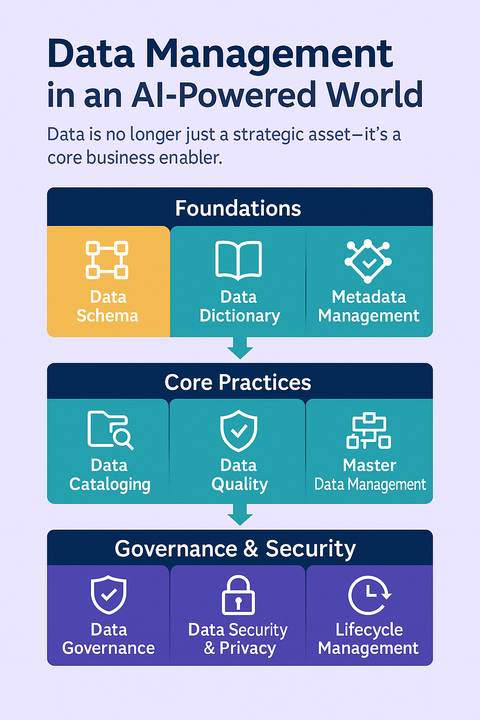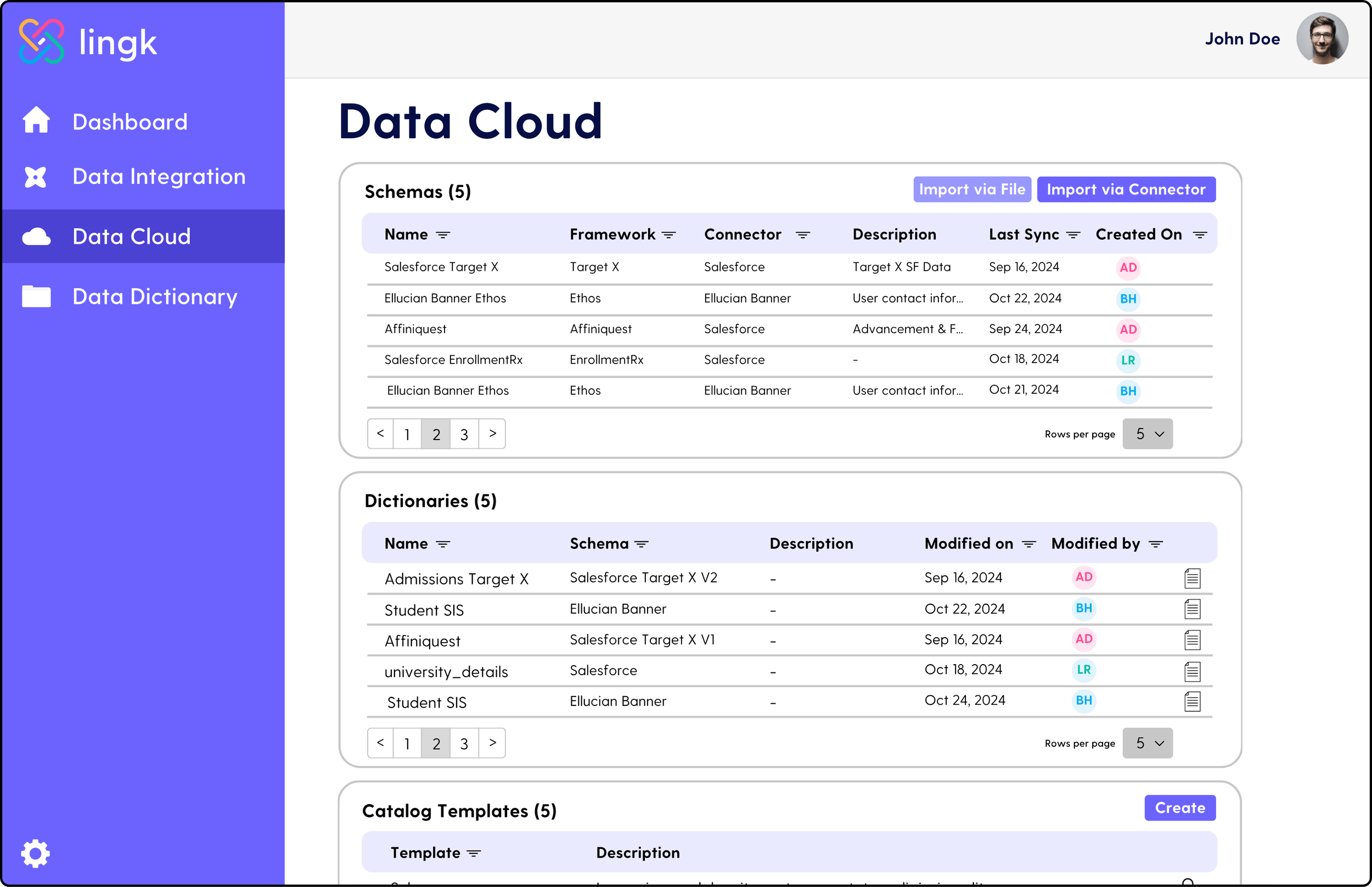What is Data Management?
In an AI-powered world, data is no longer just a strategic asset—it’s a core business enabler. But without strong data management, even your best data becomes a liability: fragmented, untrusted, and unusable.
Effective data management turns complexity into clarity—ensuring your data is secure, governed, and ready to drive confident decisions, operational agility, and AI transformation.
What is Data Management?
Data management is the comprehensive discipline of collecting, storing, organizing, maintaining, and governing data across its entire lifecycle. It ensures that data is accurate, accessible, secure, and actionable for users, systems, and decision-making processes.
Unlike a single tool or task, data management encompasses an ecosystem of practices that work together to create a trustworthy and efficient data environment. From defining data schemas to monitoring quality, every part of data management is critical to driving value from information.
Key Areas of Data Management
Let’s break down the primary components under the data management umbrella:
— What Is a Data Schema?
A data schema defines the structure and organization of data within a system. It specifies which entities (or objects) and attributes (or fields) are present, the data types of each attribute, and the relationships between entities. Think of it as a blueprint that databases and integration systems follow to store, validate, and manage data consistently.
A well-designed schema promotes data quality and consistency, simplifies integration across systems, and supports reliable analytics by providing clear expectations for how data is structured and connected.
— What Is a Data Dictionary?
A data dictionary is a centralized reference that describes the meaning, structure, and usage of data elements within a system. It provides detailed metadata for each entity and attribute—such as definitions, data types, allowed values, business rules, and relationships to other elements.
Think of it as the documentation layer that explains the data schema in business and technical terms. While a schema defines how data is structured, the data dictionary defines what the data means and how it should be used.
A comprehensive data dictionary enhances data governance, improves data literacy across teams, and supports integration, reporting, and compliance efforts by making data definitions transparent and standardized.
— What Is Data Cataloging?
Data cataloging is the process of creating an organized, searchable inventory of an organization’s data assets. A data catalog captures rich metadata—such as data definitions, lineage, classifications, ownership, and usage statistics—to help users understand and trust the data they work with.
Modern data catalogs empower teams to quickly discover, access, and reuse high-quality data, making them foundational for self-service analytics, regulatory compliance, and data democratization across the organization.
— What Is Data Governance?
Data governance is the framework of policies, roles, standards, and processes that guide how data is managed, accessed, and used across an organization. It establishes clear accountability for data ownership, defines permissions and usage guidelines, and ensures that data handling aligns with privacy, security, and regulatory requirements.
Importantly, data governance is not just about control—it’s about enabling trustworthy, consistent, and responsible data use that supports both operational needs and strategic decision-making.
— What Is Data Quality?
Data quality is the measure of how well data meets the standards of accuracy, completeness, consistency, timeliness, and validity required for its intended use. High-quality data enables confident decision-making, supports regulatory compliance, and reduces operational risk—while poor-quality data can lead to costly mistakes and missed opportunities.
Modern data management platforms provide tools for profiling, validation, deduplication, and error correction to continuously assess and improve data quality across systems and workflows.
— What Is Master Data Management (MDM)?
Master Data Management (MDM) is the practice of creating and maintaining a single, consistent, and authoritative view of an organization’s core data—such as customers, students, products, or employees—across all systems and applications.
By resolving duplicates, enforcing data standards, and synchronizing records, MDM provides a trusted source of truth that improves data accuracy, streamlines operations, and enhances analytics, reporting, and customer experiences.
— What Is Metadata Management?
Metadata is data that describes other data—such as its structure, origin, usage, ownership, and relationships. Metadata management is the practice of organizing, maintaining, and leveraging this information so teams can understand, classify, trace, and govern data across all systems and use cases.
Lingk’s Data Cloud is architected as a zero-copy metadata management platform. Instead of duplicating or moving data, Lingk uses metadata to define where data resides, how it’s structured, who owns it, how it’s accessed, and how it connects to other systems. This metadata-driven approach enables powerful capabilities like data lineage, policy enforcement, integration orchestration, and AI agent readiness—without disrupting source systems or creating data sprawl.
— What Is Data Security and Privacy?
Data security and privacy encompass the policies, technologies, and controls that protect sensitive information from unauthorized access, misuse, or exposure—while ensuring that data is handled in accordance with legal and ethical standards. This includes managing access permissions, encryption, auditing, and compliance with regulations such as GDPR, FERPA, and HIPAA.
Modern data management platforms help organizations automate these protections—enforcing governance policies, monitoring usage, and reducing the risk of data breaches while maintaining trust with stakeholders.
— What Is Lifecycle Management?
Lifecycle management is the practice of governing data through its entire lifespan—from creation and active use to long-term storage, archival, and eventual deletion. It ensures that data is retained for the appropriate duration, remains accessible when needed, and is securely disposed of when no longer required.
Effective lifecycle management reduces storage costs, mitigates risk, and helps organizations comply with data retention policies, regulatory requirements, and internal governance standards.
What Challenges does Data Management Solve?
As organizations generate and use more data across disconnected systems, maintaining control becomes increasingly difficult. Without a solid data management strategy, teams rely on inconsistent sources, AI and analytics produce unreliable results, compliance and security risks grow, and IT struggles with poor visibility and system sprawl.
Data management addresses these challenges by bringing order, consistency, and control to the data environment. It empowers organizations to:
Trust the accuracy and reliability of their data
Make data easy to find, understand, and reuse
Enforce governance, privacy, and compliance standards
Power integrations, AI agents, and advanced analytics
Unify data across platforms for streamlined reporting and operations
Detect and fix data issues before they cause impact
Minimize manual work and enable confident decision-making
“We use the Lingk Platform as both an iPaaS and data management platform, along with their integration and systems experts to assist us. I can’t say enough good things about them as a company and their product. They honestly saved us several times over this past year alone.”
Lebanon Valley College
What’s the Relationship Between Data Integration and Data Management?
Data integration is the process of connecting, combining, and synchronizing data across diverse systems. It plays a critical role in enabling effective data management.
While integration ensures data flows smoothly between applications, data lakes, and analytics tools, it’s data management that ensures the integrated data is accurate, governed, and fit for use.
In short: data integration brings data together, and data management makes it trusted and usable. Together, they provide the backbone of a data-driven organization.
Why Choose Lingk for Data Management and Integration?
Most platforms focus on either integration or data management—but Lingk combines both in a unified solution built for today’s hybrid, multi-cloud environments.
With Lingk, you benefit from:
A Metadata-first, Zero-copy Architecture that minimizes data movement
Intelligent Data Agents that automate integration and governance workflows
No-code/low-code tools that empower both IT teams and business users
Built-in data quality, lineage, and governance features
Support experts for cloud, on-prem, and hybrid deployments
Whether you're powering AI agents, harmonizing enterprise data, or enabling self-service analytics, Lingk helps you trust your data and put it to work—faster and smarter.
Ready for a Unified Approach to Data?
Lingk brings integration and data management together in a single platform—helping institutions streamline operations, elevate experiences, and accelerate innovation with trusted, AI-ready data.


